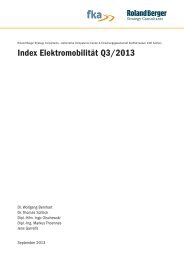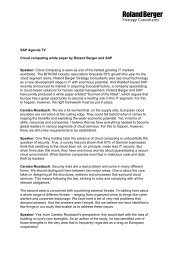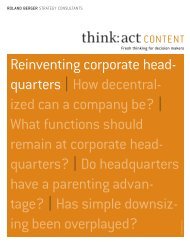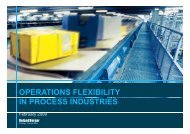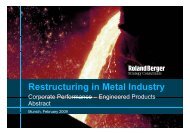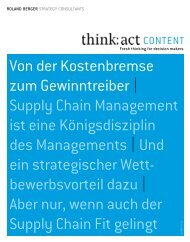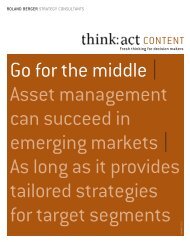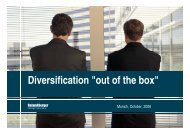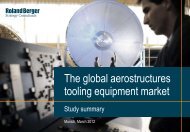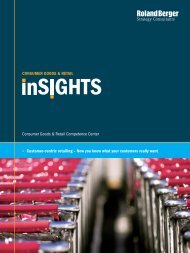"Automotive inSIGHTS 2/2010" (PDF, 3784 KB - Roland Berger
"Automotive inSIGHTS 2/2010" (PDF, 3784 KB - Roland Berger
"Automotive inSIGHTS 2/2010" (PDF, 3784 KB - Roland Berger
Create successful ePaper yourself
Turn your PDF publications into a flip-book with our unique Google optimized e-Paper software.
AUTOMOTIVE<br />
<strong>Automotive</strong> Competence Center Client Magazine No. 02_2010<br />
> Mobility concepts – Forever the "next big thing", or is a breakthrough ahead?<br />
> Interview: Erich Sixt, Chief Executive Officer, Sixt AG<br />
> <strong>Automotive</strong> 2025 – Challenges and opportunities ahead
Editorial<br />
Dear Reader,<br />
In the latest issue of <strong>Automotive</strong> <strong>inSIGHTS</strong>, we take a close<br />
look at the topic of mobility. We analyzed a wide variety of<br />
approaches to developing mobility concepts and share the<br />
results with you. In an exclusive interview with Erich Sixt,<br />
CEO of Sixt AG, we discussed the specifics of innovative<br />
mobility concepts.<br />
This issue also provides you with a preview of our upcoming<br />
study "<strong>Automotive</strong> industry 2025 – How will the automotive<br />
landscape change?". The study examines megatrends and<br />
their impact on key markets, technologies, business models<br />
and the related HR strategies in the automotive industry.<br />
I wish you inSIGHTful reading and look forward to your<br />
feedback.<br />
Kind regards,<br />
Ralf Kalmbach<br />
Contents<br />
A look around the world<br />
3 <strong>Automotive</strong> markets in South America<br />
6 Electric Vehicles in China and Japan<br />
Mobility concepts<br />
10 Forever the "next big thing", or is a<br />
breakthrough ahead?<br />
<strong>Automotive</strong> 2025<br />
14 Challenges and opportunities ahead<br />
18 Books & Studies<br />
Famous cars: Mercedes W113 "Pagoda"<br />
Powertrains and fuels of the future<br />
20 10 theses about passenger and<br />
commercial vehicles<br />
24 Interview: Erich Sixt<br />
<strong>Automotive</strong> Competence Center<br />
contacts worldwide<br />
Published by:<br />
<strong>Roland</strong> <strong>Berger</strong> Strategy Consultants GmbH,<br />
Mies-van-der-Rohe-Straße 6, 80807 Munich<br />
Editors-in-chief:<br />
Ralf Kalmbach and Ralf Landmann<br />
Editors:<br />
Dana Rehfuß and <strong>Roland</strong> <strong>Berger</strong> Language Service<br />
Layout:<br />
RB_DesignTeam<br />
Printed by:<br />
Girodruck, Hamburg<br />
Circulation:<br />
3,500, published three times a year<br />
No reprints without prior permission of the publisher
A LOOK AROUND THE WORLD<br />
<strong>Automotive</strong> markets in South America<br />
South America – A forgotten continent rediscovered<br />
For the last decade, little attention was paid to South<br />
American automotive markets as global attention<br />
fixed on the Eastern emerging countries: Russia,<br />
India, and China. But as global focus is shifting again<br />
from restructuring to global growth, South American<br />
markets are stealing back into the spotlight.<br />
South American countries currently account for 6% of<br />
global vehicle production and consumption with over<br />
4 million light passenger vehicles and 200,000 commercial<br />
vehicles. Growth prospects for the next few years<br />
are abundant (Fig. 1).<br />
Significant growth expected in Brazil<br />
On the forefront of South American growth is Brazil,<br />
accounting for more than 75% of the South American<br />
markets. After a long crisis from 1998 to 2004, Brazil<br />
has emerged as a strong and stable economy. 78% of<br />
its 190 million people have already achieved an income<br />
level that allows them to purchase a vehicle.<br />
Over the next decade, both the number of inhabitants and<br />
the income level will continue to rise, reaching 215 million<br />
people by 2020 – and nearly 180 million of those classified<br />
in income groups attractive to the automotive industry.<br />
With these numbers, it is no surprise that total vehicle<br />
consumption and production will reach nearly 6 million<br />
vehicles per year in 2020, cementing Brazil's position<br />
as the 4th largest consumer and 5th largest producer<br />
of vehicles worldwide.<br />
Car manufacturers and suppliers alike are already starting<br />
to prepare for this growth. More than EUR 10 billion is to<br />
be invested by OEMs in creating new or upgrading existing<br />
production capacity as well as launching new vehicles just<br />
by 2013. New vehicle plants are currently being constructed<br />
by Toyota, Hyundai and even the Chinese carmaker<br />
Chery. These investments will increase vehicle production<br />
capacity by 1 million cars, reaching 4.8 million vehicles<br />
in 2013 (Fig. 2). Another EUR 9 billion is being invested by<br />
automotive suppliers to expand their capacity to support<br />
this growth.<br />
News<br />
3
4<br />
A LOOK AROUND THE WORLD<br />
Besides all these investments, Brazil's automotive industry<br />
is expected to become even more diverse. Even though<br />
nearly all established global brands are already present in<br />
Brazil, more than 70% of the passenger vehicle market is<br />
dominated by Volkswagen, FIAT, General Motors and Ford.<br />
The picture is similar in the commercial vehicle segment,<br />
with Volkswagen (now part of MAN) and Mercedes-Benz<br />
accounting for 60% of the total market. Even though these<br />
market leaders will also continue to grow, their market<br />
domination will slowly weaken as competition becomes<br />
more fierce.<br />
Another clear sign of the changing market environment is<br />
the vehicle portfolio. A few years back, most of the vehicle<br />
platforms being produced and sold were outdated. OEMs<br />
are now overhauling and updating their vehicle portfolio.<br />
Supported by new emissions and safety regulations, South<br />
American vehicles of the next decade will be much closer<br />
to the current global vehicle portfolio than ever before.<br />
Argentina – Uncertain market pulled ahead by Brazil<br />
Former South American star Argentina is today largely<br />
overshadowed by its big neighbour Brazil. Years of failed<br />
economic policy and political instability have left<br />
Argentina uncertain of its direction.<br />
Nevertheless, more than 600,000 vehicles will be produced<br />
there in 2010 and production volumes are forecast<br />
to reach more than 900,000 vehicles by 2020.<br />
Two factors will drive this expected growth. Despite<br />
the current economic trouble, the Argentinean economy<br />
continues to thrive, driven by vast agricultural production.<br />
Current inflationary tendencies are supporting the acquisition<br />
of high-value consumer goods, namely: cars.<br />
In addition, demand from Brazil leads to increasing<br />
exports to the neighboring country.<br />
Many major car manufacturers have already invested<br />
heavily in Argentina (including Volkswagen, FIAT, GM, Ford,<br />
PSA, Renault, and Toyota) and are unwilling to cease local<br />
production. Japanese carmaker Honda has decided to<br />
build its newest South American plant in Argentina<br />
(Fig. 3).<br />
However, Argentina is much more than just Brazil's little<br />
brother. While Brazil focuses primarily on production in the<br />
A and B segments, nearly half the output of Argentinean<br />
car plants are C-segment cars, pick-ups, SUVs and vans.<br />
This focus ensures the strategic viability of Argentinean<br />
production.
A LOOK AROUND THE WORLD<br />
Although many suppliers had left Argentina over the past<br />
decade, the past few years have also seen an increasing<br />
amount of investment. Leading global suppliers, including<br />
Gestamp, Magneti Marelli, Mahle, Mann + Hummel and<br />
ZF are currently manufacturing in Argentina.<br />
The "northern" South American markets: Colombia<br />
and Venezuela<br />
When discussing South America, Colombia and Venezuela<br />
are often forgotten. To be sure, Venezuela's current<br />
political situation does nothing to make investments and<br />
growth particularly attractive. As continued nationalization<br />
of foreign invested capital remains under discussion,<br />
most OEMs and suppliers are currently very cautious<br />
when dealing with Venezuela – and rightly so. However, a<br />
change in the current political situation could very quickly<br />
put Venezuela back on the map with a future automotive<br />
production forecast of nearly 200,000 vehicles.<br />
Its neighboring market Colombia is doing much better.<br />
Driven by strong economic growth and increased safety<br />
and stability, the market is ready to emerge as one of<br />
the world's future automotive growth markets. According<br />
to current forecasts, automotive production output will<br />
remain below 200,000 vehicles up through 2020.<br />
However, these forecasts are built on the current industry<br />
structure which is largely characterized by CKD production<br />
with imports from the US and Asia. With continuing growth,<br />
this structure could change rapidly, thus driving production<br />
growth in Colombia far beyond current forecasts.<br />
Don't miss out on South American growth prospects<br />
Many companies, OEMs and suppliers alike, are currently<br />
reviewing their position and strategy regarding South<br />
America. With current capacity utilization of >90% and<br />
profitability above the global average, the South American<br />
countries provide attractive growth potential in a safe<br />
and stable environment.<br />
Even companies already present in South America are<br />
reviewing their setup. Rising production costs and strong<br />
growth rates require new production structures in terms<br />
of location, size and automation. With the right strategy,<br />
companies will be able to participate in one of the most<br />
dynamic markets of the next decade.<br />
Stephan Keese<br />
Principal,<br />
<strong>Roland</strong> <strong>Berger</strong> Strategy Consultants, São Paulo<br />
stephan_keese@br.rolandberger.com<br />
5
6<br />
A LOOK AROUND THE WORLD<br />
Electric Vehicles in China and Japan<br />
China and Japan are rapidly stepping up their efforts<br />
to popularize EVs. In Japan, major OEMs such as<br />
Mitsubishi and Nissan are taking the lead with actual<br />
EV launches. Aggressive steps are also being taken in<br />
China, which surpassed the US in 2009 to become the<br />
world's largest market. The world of EVs offers a variety<br />
of vehicle characteristics and applications. As we take<br />
a look at the prospects for EV popularization, we will<br />
also identify the key success factors for OEMs in both<br />
the Japanese and Chinese markets.<br />
Before considering EV popularization in Japan, we first<br />
need to understand the characteristics of Japanese<br />
consumers. In short, they are "exacting and conservative".<br />
Their high expectations of products related to safety and<br />
security (such as cars and food) can be clearly understood<br />
by looking at the recall numbers of Japanese companies.<br />
In the past 7 years in China, Guangzhou Toyota had the<br />
highest recall numbers, followed by Guangzhou Honda<br />
and then FAW Toyota. While 7 Japanese OEMs ranked<br />
in the top 10 of recall numbers, Chinese OEMs such as<br />
Tianjin FAW, Chana Automobile, BYD and JAC counted<br />
zero recalls.<br />
The fact that Japanese OEMs (which set their standards<br />
according to Japanese consumers) have high numbers of<br />
recalls shows us how exacting Japanese consumers are –<br />
sometimes too much so.<br />
At the same time, they are hesitant to accept new<br />
products. Hyundai, for example. Even though the model<br />
launched in Japan was reasonably attractive in terms<br />
of price and specs, it was not accepted in the market<br />
and ended up being withdrawn in just 9 years. Japanese<br />
consumers are clearly less interested in emerging players,<br />
and tend to value European/Japanese brands with a long<br />
history of high quality specifications.<br />
As for the EV model lineup in Japan, both the highperforming<br />
EVs offered by existing Japanese OEMs and<br />
mid-performing EVs offered by venture companies and<br />
foreign OEMs are likely to coexist in the early days of<br />
the EV market (Fig. 1). Although it is expected that the<br />
balance will swing toward high-performing EVs, given the<br />
Japanese consumption behavior described above and the<br />
government's position (has not yet decided how to regulate<br />
limited-performance EVs, such as the quadricycle).
A LOOK AROUND THE WORLD<br />
What then would the applications for EVs be? They should<br />
be limited to short-range transportation in urban areas,<br />
as priority is given to safety. Applications may also expand<br />
to include commercial uses such as pickup and delivery<br />
vehicles used on a particular route, private uses like car<br />
sharing and so on.<br />
The potential of expansion largely depends on consumers'<br />
first impressions of EV. One user took a 20-minute drive<br />
through his neighborhood via EV car sharing (Fig. 2). His<br />
conclusion was: "will not use anymore since it offers no<br />
reliability". This was based on his report that: "Driving<br />
range was halved when the heater was turned on. Cannot<br />
trust it any more"; "Driving range was given as 90 km with<br />
a 95% charge, although it should be 160 km at 100%";<br />
"The silence felt so weird. Might get used to it, but still<br />
feel anxious as it is too quiet"; "It took 10 minutes to<br />
fit the charging socket. Cannot do this every day".<br />
In contrast, another user enjoyed a long-distance drive<br />
to the suburbs with a rental car. His impression after<br />
the drive was that "the EV is practical enough". He understood<br />
through actual experience that the driving range –<br />
the biggest initial concern – was not such a problem.<br />
1) The number of pilot cities has already reached 25 and will increase steadily<br />
Everything takes some getting used to. Especially for cars:<br />
people have a certain image from conventional engine<br />
cars, and a new vehicle like an EV might at first create an<br />
uncomfortable impression. But this discomfort does not<br />
last long. Acceptance of EVs depends heavily on whether<br />
drivers can be given enough time behind the wheel to get<br />
used to the new sensation.<br />
Popularizing EVs in Japan depends on the amount of effort<br />
and information on the part of the provider. Careful prepa-<br />
ration, such as developing a vehicle that will be accepted<br />
by consumers who put a premium on security and safety,<br />
will be necessary, as will offering test drives so that<br />
consumers can experience the car's practicality for<br />
themselves.<br />
Meanwhile, EV popularization in China is due largely to<br />
government policy (Fig. 3). Full-fledged popularization of<br />
private cars still has a ways to go, given that the largescale<br />
EV project "10 cities, 1,000 vehicles" 1) still focuses on<br />
public transportation such as buses and taxis. However,<br />
the growth of the Chinese automobile market pushed it<br />
almost to number one in just 10 years. There is still plenty<br />
of room for EVs on the market, and they are likely to gain<br />
popularity rapidly, if the right product is launched.<br />
7
8<br />
A LOOK AROUND THE WORLD<br />
What, then, is the right product for Chinese consumers?<br />
They are described as "rational and practical". Each consumer<br />
makes decisions about what to buy based on what<br />
is really necessary and what is not, given that they can<br />
presumably not purchase everything they want.<br />
As a result, a wider variety of EVs might be accepted in<br />
China compared to Japan. Consumers in large cities such<br />
as Shanghai are likely to value status, thus models with<br />
relatively high specs launched by state-owned, foreign<br />
and joint venture OEMs might garner a large part of the<br />
market. Such models would rank close to ICE vehicles, for<br />
example with a driving range of more than 150 km and<br />
electronic control to counter mechanical failure or driver<br />
error. Though the price range of EUR 20,000 to 30,000 is<br />
high for the normal income level, Chinese consumers tend<br />
to be practical about price.<br />
On the other hand, consumers in the suburbs do not have<br />
all that much purchasing power. EV popularization would<br />
be mainly low-spec EVs, offered by private OEMs or venture<br />
businesses. However, these will not differ dramatically<br />
from EVs offered by foreign or JV OEMs, since they will also<br />
use Li-ion batteries and electronic control units. But the<br />
price of these cars will be the major difference since they<br />
don't have enough of a brand premium.<br />
As for rural cities, EVs with completely different sizes or<br />
driving performance, such as 2- or 3-wheeled EVs, would<br />
be the main market driver. These will be offered by local<br />
SMEs to the tune of thousands of euros, and will provide<br />
mobility essential to daily life. However, the battery is likely<br />
to be acid-lead or Ni-MH and the driving range would be<br />
just tens of kilometers.<br />
The government is also pushing EV development, and a<br />
plan to invest EUR 12 billion over the next 10 years in<br />
EV/PHEV and infrastructure development was recently<br />
announced. Of that, EUR 5 billion will be invested in EVs<br />
and their key components over the next 5 years.<br />
Funded by these government programs, EV launches by<br />
local OEMs are likely to accelerate. New JVs are also<br />
entering the market, joining existing OEMs (government,<br />
foreign, JV, private). Competition is becoming more severe,<br />
not only through increases in the number of vehicles, but<br />
also quality improvement. We are also seeing initiatives<br />
such as SAIC Group and SAIC Motor co-investing in an<br />
independent NEV company (Jieneng) and building a huge<br />
R&D center (Fig. 4). Another example is BYD's joint venture<br />
with Daimler for development. In this respect, the<br />
key success factor is speed.
A LOOK AROUND THE WORLD<br />
The greatest risk is to fall behind in this EV development<br />
race, and it is a mistake to take too much time trying to<br />
attain perfection. Fortunately, trouble after the launch<br />
tends not to matter so much if it is handled quickly, at<br />
least in China. BYD frequently faced major problems after<br />
launching its product, such as breakdowns on the road,<br />
but after a year of continuous improvement, the frequency<br />
of such incidences seems to have dropped dramatically.<br />
Such problems after launch are usually not fatal in China,<br />
as Chinese consumers tend to be practical-minded, finding<br />
that "these things just happen with a new model",<br />
or "it can be fixed if it's broken". These consumer characteristics<br />
need to be incorporated into any successful<br />
market approach.<br />
In short, Japan's exacting consumers require well-developed<br />
products, and China's practical-minded consumers<br />
require quick product launch. There is no right or wrong<br />
here; rather, it is important to recognize these market<br />
characteristics in order to seize business opportunities<br />
in this growing market.<br />
Jun Shen<br />
Partner,<br />
<strong>Roland</strong> <strong>Berger</strong> Strategy Consultants, Shanghai<br />
jun_shen@cn.rolandberger.com<br />
Satoshi Nagashima<br />
Partner,<br />
<strong>Roland</strong> <strong>Berger</strong> Strategy Consultants, Tokyo<br />
satoshi_nagashima@jp.rolandberger.com<br />
Junyi Zhang<br />
Project Manager,<br />
<strong>Roland</strong> <strong>Berger</strong> Strategy Consultants, Shanghai<br />
junyi_zhang@cn.rolandberger.com<br />
Hitoshi Kaise<br />
Project Manager,<br />
<strong>Roland</strong> <strong>Berger</strong> Strategy Consultants, Tokyo<br />
hitoshi_kaise@jp.rolandberger.com<br />
9
10<br />
MOBILITy CONCEpTS<br />
Forever the "next big thing",<br />
or is a breakthrough ahead?<br />
Comprehensive mobility concepts are currently driven<br />
by the dynamics of electromobility, a topic on everyone's<br />
lips – However, we still do not know how profit-<br />
able this business will be over the next 10 years, or<br />
what role the different players will assume there. In the<br />
following we will give a short overview about different<br />
initiatives driven by automotive manufactures but also<br />
by companies from outside the automotive industry. As<br />
outlook we will show, which basic requirements have to<br />
be fulfilled by every market player to launch and operate<br />
mobility concepts in a profitable way.<br />
Current situation<br />
Megatrends such as demographic change or the quest<br />
for sustainability will impact upcoming technological and<br />
social developments 1) . For example, we regularly hear that<br />
the mobility behavior of customers will change, and innovative<br />
mobility concepts are the talk of the town. However,<br />
the extent to which mobility needs will change and how<br />
carmakers, rental agencies and investors can best prepare<br />
themselves for these developments remains unclear.<br />
For quite a few years now, besides mostly locally operated<br />
and non-commercial carsharing schemes, more and more<br />
commercial (pilot) concepts have been emerging in Europe<br />
and the US. Driving this development are companies<br />
beside the established automotive manufacturers (e.g.<br />
Streetcar and Zipcar). Many of the concepts are still in the<br />
test phase and are therefore generally not yet profitable.<br />
The still-small number of users is often not enough to<br />
cover the costs of the vehicle fleets and infrastructure.<br />
German rail company Deutsche Bahn, for example, is<br />
rigorously expanding its mobility products and services 2) .<br />
Traditional car rental agencies are gaining experience here<br />
as well – such as Sixt, which launched its SIXTI Car Club<br />
in Berlin and Munich – in order to tap additional business<br />
potential 3) .<br />
The discussion is gaining further momentum, especially<br />
due to the increasing number of initiatives in electromobility.<br />
High battery prices in particular are leading to<br />
new operator concepts that deviate from the traditional<br />
purchase model. Better Place, a pioneer in this area,
MOBILITy CONCEpTS<br />
clearly sees itself as a mobility provider. Not only does<br />
it provide the vehicles, its services range from supplying<br />
electricity to offering extensive navigation services.<br />
Mobility services, and car-sharing initiatives in particular,<br />
are currently a trend mainly found in Western industrialized<br />
countries. Especially the German market is growing<br />
at a rate second only to the US. Already today, in Germany<br />
alone there are approx. 160,000 people involved in car-<br />
sharing initiatives and have access to roughly 4,700<br />
vehicles. Experts expect these numbers to rise to over<br />
one million people and almost 20,000 vehicles in<br />
Germany by 2016.<br />
If these concepts catch on, this could represent an additional<br />
threat to carmakers' sales. The break-even point for<br />
owning a vehicle is still today at approx. 10,000 km a year,<br />
according to the German federal association CarSharing 4) .<br />
A study carried out by AXA Group shows that already today,<br />
46% of the population drive less than this threshold and<br />
20% even drive less than 5,000 km 5) . Once customer get<br />
past the emotional ties of owning a vehicle and the status<br />
symbol it represents, car sharing may become a viable<br />
option, especially if they live in an urban area. A study<br />
by Frost & Sullivan predicts that mobility concepts could<br />
cause 1 million cars per annum to be sold less in Europe<br />
in the midterm.<br />
However, key questions involving mobility concepts<br />
have not yet been conclusively answered in the industry,<br />
such as:<br />
> How are mobility needs actually changing<br />
in the various markets and consumer groups?<br />
> What impact/risks do these have on/for traditional<br />
business models in the automotive industry?<br />
> What do possible alternative new business models<br />
look like and what new market players will emerge?<br />
> How should automotive manufacturers and service<br />
providers respond?<br />
> What role does electromobility play in the longterm?<br />
Daimler, Peugeot and BMW belong to the first automotive<br />
manufacturers to respond with comprehensive pilot<br />
projects. Besides the positive PR that goes along with<br />
such activities, they are motivated by the specific goal<br />
of generating profits in the medium term.<br />
1) Refer also to "<strong>Automotive</strong> 2025" in <strong>inSIGHTS</strong>, 1/2010.<br />
2) All car-sharing activities are consolidated under its new name "Flinkster – Mein Carsharing". This means that the more than 110,000 car-sharing<br />
Deutsche Bahn customers have 4,500 vehicles at their disposal throughout Europe at over 1,900 stations and in more than 580 cities.<br />
3) Sixt is trying to reach "young and price-conscious city dwellers" at over 45 locations in Berlin and Munich. As of January 2010, there were already<br />
approx. 1,600 users with access to 62 vehicles.<br />
4) Information from "Bundesverband CarSharing e.V." Other experts state 7,000 kilometers as the critical limit.<br />
5) AXA Traffic Safety Report 2009.<br />
11
12<br />
MOBILITy CONCEpTS<br />
Examples of their activities:<br />
> With its "car2go" project, which started in Ulm, Germany<br />
and Austin, Texas in 2009, Daimler has considerably<br />
exceeded its own expectations and has already<br />
announced the launch in Hamburg in cooperation with<br />
Europcar in 2011. To broaden this service, Daimler<br />
is now kicking off its new "car2gether" concept,<br />
an online car sharing community<br />
> Peugeot's "mu by peugeot" project was launched in<br />
Paris and later introduced in Berlin. This project takes<br />
the concept a step further and offers a wide range of<br />
mobility services, in addition to just the vehicle. These<br />
services cover the entire model range from bicycles to<br />
convertibles, and Peugeot is planning to quickly include<br />
its "electromobility" program and offer electric vehicles<br />
> BMW launched its "project i": With this megacity<br />
vehicle, the group wants to offer a new kind of solution<br />
for sustainable mobility in urban areas. The concept is<br />
expected to hit the markets in 2013 under a BMW subbrand.<br />
Over the long term, "project i" will be followed<br />
by further refinement across the entire BMW Group,<br />
spurred on by new ideas and projects in production,<br />
development and sales<br />
As manufacturers create their own mobility concepts,<br />
a variety of variables can come into play. Depending on<br />
where companies choose to fall in the spectrum between<br />
pure vehicle manufacturing and being a full-service mobility<br />
provider, the concepts will differ radically from each<br />
other. But all of the ongoing pilot projects have one thing<br />
in common: they allow the established manufacturers to<br />
gather valuable experience whether a strong productionoriented<br />
automotive group could be transformed into<br />
a mobility provider.<br />
The examples show that mobility concepts are becoming<br />
more and more important for the automotive industry.<br />
Whether manufacturers will actually be in a position to<br />
establish the infrastructure and service organization<br />
necessary for offering a really comprehensive portfolio<br />
of mobility services (such as car sharing) remains<br />
to be seen.<br />
Outlook: What needs to be done now?<br />
For a mobility concept to be successful, it needs basically<br />
to be attractive to customers. Only in this way can a provider<br />
secure enough users. Therefore, to be attractive,<br />
a mobility concept must fulfill some basic requirements:
MOBILITy CONCEpTS<br />
> Available: A vehicle may be only a negligible distance<br />
farther away than one's own would be. It must meet<br />
customers' requirements regarding model and features<br />
> Simple: Using the service must be no more complicated<br />
than "get in and turn the key" – but at the same<br />
time, there must be safeguards against misuse<br />
> Affordable: The total cost of ownership advantages<br />
over the traditional car purchase must be clear and<br />
passed on to the customer<br />
> Complete: To set itself apart from the traditional<br />
rental model, the mobility concept should combine<br />
various modes of transportation<br />
> Innovative and different: Especially in the startup<br />
phase, it is important to generate a high degree of<br />
media exposure to reach the minimum number of<br />
users and to stand out from existing car-sharing<br />
offers<br />
Besides an attractive offer and a large number of users,<br />
companies need sufficient infrastructure and the corresponding<br />
management know-how in services for these<br />
mobility concepts to be profitable over the long term.<br />
These requirements are currently best met by car rental<br />
companies. Manufacturer-driven models can be successful<br />
if they rigorously build up their own access to networks<br />
and know-how, or buy it in via collaborative partnerships<br />
or acquisitions, such as the partnership between<br />
Daimler's car2go and Europcar wich has been<br />
establisehed.<br />
Against this backdrop, manufacturers need their own<br />
mobility strategies. Manufactures have to evaluate the<br />
importance of changing mobility behavior in light of the<br />
resulting risks and opportunities, and develop strategies<br />
to respond to these changes.<br />
Carmakers, car rental companies and mobility service<br />
providers such as railway companies have to determine if<br />
comprehensive mobility concepts are the "next big thing"<br />
for them. They need to figure out when a true breakthrough<br />
can be expected and to what extent their existing business<br />
models need to be adapted and expanded. These<br />
important points clearly need to be decided at the upper<br />
management levels.<br />
Ralf H. Landmann<br />
Partner,<br />
<strong>Roland</strong> <strong>Berger</strong> Strategy Consultants, Frankfurt<br />
ralf_landmann@de.rolandberger.com<br />
Sebastian Gundermann<br />
Project Manager,<br />
<strong>Roland</strong> <strong>Berger</strong> Strategy Consultants, Frankfurt<br />
sebastian_gundermann@de.rolandberger.com<br />
Jan-philipp Hasenberg<br />
Senior Consultant,<br />
<strong>Roland</strong> <strong>Berger</strong> Strategy Consultants, Frankfurt<br />
jan-philipp_hasenberg@de.rolandberger.com<br />
13
14<br />
AUTOMOTIVE 2025<br />
Challenges and opportunities ahead<br />
It's 2010: the financial crisis is over and it is a good<br />
time to start thinking about strategic issues again.<br />
By strategic issues, we mean those fifteen years from<br />
now – or, putting it another way, two product lifecycles<br />
from now. What will the automotive landscape be like<br />
in 2025? How will the face of the automotive industry<br />
have changed by then? What megatrends will change<br />
mobility in the upcoming years? And what will make<br />
the winners of the future succeed?<br />
These are the questions we at <strong>Roland</strong> <strong>Berger</strong> Strategy<br />
Consultants and Amrop Delta, a leading executive search<br />
company, have been asking. The study began earlier this<br />
year, and so far we have surveyed more than 60 leading<br />
companies, organizations and experts around the world.<br />
Our survey included many carmakers and suppliers, as<br />
well as companies that will be interfacing closely with<br />
the automotive industry, such as utilities, banks, research<br />
institutions and public sector organizations (Fig. 1).<br />
During these interviews, we validated the five megatrends<br />
we had defined in advance, then analyzed how they<br />
affect the automotive industry. These five megatrends<br />
are as follows (Fig. 2):<br />
1. Demographic change<br />
2. Sustainability<br />
3. Behavioral change<br />
4. political change<br />
5. Technological change<br />
Based on the interview findings, market research and<br />
our own analysis, we are defining what these megatrends<br />
mean for the automotive industry. These implications<br />
can be clustered by:<br />
1. Markets, customers, products<br />
2. Business models, value chains, partnerships<br />
3. Staff, business organizations, change<br />
The study is still being conducted and will be released<br />
in late 2010. However, we already have some interesting<br />
findings.<br />
1. Markets, customers, products<br />
Overall, there will be a dramatic shift to Asia, with sales,<br />
production capacity and employment shifting to the<br />
region or being set up there for the first time.
AUTOMOTIVE 2025<br />
Regional trade blocks such as MERCOSUR and ASEAN are<br />
expected to grow. This will mean a shift toward low-cost<br />
locations within those blocks. This trend will be accelerated<br />
by rising transport costs, political regulations and<br />
fluctuating exchange rates. Suppliers will follow the<br />
carmakers down this road.<br />
In the best case scenario, electric vehicles will account<br />
for up to 10% of all new vehicle sales by 2025. Their low<br />
range, heavy weight and high cost will limit their popularity.<br />
Hybrids will be more popular and reach a 40% share.<br />
PHEVs in particular combine the advantages of internal<br />
combustion engines with those of electric powertrains,<br />
without being dependent on the nearest charging point<br />
(which will still not be universal by 2025). Internal combustion<br />
engines will still account for 50% of new car sales.<br />
By 2025, many vehicles will always be online, sending<br />
and receiving information. Connectivity is a key factor<br />
here. Vehicles will communicate with one another and their<br />
environment, although we do not yet know exactly how.<br />
Google believes C2C and C2E communications will be<br />
integrated in cars via smart devices. The benefit of this is<br />
that new developments can quickly become widespread<br />
at low costs.<br />
QUOTE: Dr. Wieland Holfelder, engineering director at<br />
Google: "[….] we believe that by 2025, all vehicles will<br />
be always online, either directly or via equipment passengers<br />
bring with them, via 3G and 4G mobile phone<br />
networks.<br />
In other words, most data for infotainment and IT services<br />
that are not real-time-critical will be shared online by that<br />
time. The future is in Internet-based applications." However,<br />
many other people we spoke to do not think it makes<br />
sense to integrate safety-enhancing C2C and C2E applications<br />
via an interface between a vehicle and a smart<br />
device. OEMs could find themselves liable if clean connections<br />
cannot be made between vehicle and device (if their<br />
iPhone crashes or is hacked into, for example). They prefer<br />
to integrate safety-critical C2C and C2E functionalities at<br />
the factory, which would push back the market launch until<br />
well after 2025. The widespread usage of such functions<br />
would also be delayed.<br />
The idea that cars of the future – connected via intelligent<br />
traffic solutions – will have fewer accidents and that the<br />
weight and cost of active and passive safety features<br />
could therefore be reduced, is not likely to become reality<br />
until well after 2025. Perhaps the concept could be<br />
piloted in one of the new megacities that will have been<br />
created by then – if city planners design a corresponding<br />
strategy (for electric vehicles only) for the city center.<br />
The trend of "demotorization" will first emerge in the big<br />
cities of established industrial nations. People in the new<br />
megacities, almost all of them in Asia, will find their values<br />
changing rapidly. Even today, car ownership rates are fairly<br />
low among the under-30s, and will decrease further by<br />
2025. And the cohort effect means the next age group will<br />
follow these behavioral patterns, even if they do not need<br />
to financially.<br />
15
16<br />
AUTOMOTIVE 2025<br />
Mobility concepts that include car sharing models will<br />
become increasingly widespread in mature markets. Some<br />
people might even decide not to learn to drive at all.<br />
2. Business models, value chains, partnerships<br />
New business models are likely to arise: they will not be<br />
about just selling cars, but about integrating software and<br />
hardware, or different hardware modules. One example<br />
here is car sharing, a business that will have to be taken<br />
seriously by 2025, as the private economy moves in. Given<br />
that one car-sharing vehicle can replace up to forty cars,<br />
OEMS will have to try to integrate this business and generate<br />
other alternative sales sources – before somebody<br />
else does. C2C and C2E communication services<br />
are another example.<br />
The rising proportion of corporate owners (company<br />
cars, car hire firms, municipalities, car-sharing companies)<br />
will make it harder to achieve premium prices (buying<br />
center effect). Margins will be eroded, and there will be<br />
more direct sales. This will tend to weaken retailers' positions.<br />
On the other hand, a positive buying and service<br />
experience will become increasingly important when it<br />
comes to choosing brands and for customer satisfaction.<br />
Customer contact will become increasingly important as<br />
customers' needs become more individualized, and the<br />
retail experience must do more to justify the high prices<br />
of premium and luxury cars.<br />
Resource prices will continue to rise, and prices will fluctuate<br />
even more, driven partly by the increasing share of<br />
renewable energies. Fluctuating prices, in turn, will provide<br />
the basis for new business models (such as domestic<br />
power stations made by green power provider Lichtblick<br />
AG) and product innovations (smart metering-capable<br />
products such as the washing machines presented by<br />
Miele at IFA 2010, a consumer electronics trade fair).<br />
To ensure further investment in sustainable technologies<br />
and cope with increasing price-sensitivity, innovations/<br />
components will not remain exclusive to a brand or<br />
product for long. Sharing components and platforms will<br />
become standard, even between different companies. Cost<br />
pressures will force the industry to keep on consolidating.<br />
3. Staff, business organizations, change<br />
The expanding range of technologies will not lead OEMs<br />
and OESs to increase their R&D departments across the<br />
board by 2025. Many simply do not have the engineers<br />
available.<br />
Countries with aging populations will therefore be looking to<br />
extend the working lives of the workers they have (through<br />
flexible working models that reflect their personal interests and<br />
financial needs). The war for talent will escalate at the same<br />
time: a shortage of engineers and skilled specialists will<br />
inhibit growth, particularly when it comes to MINT (mathematics,<br />
IT, natural sciences and technology) graduates.<br />
Forecasts say Germany alone will have a shortage of 1.8 million<br />
specialists by 2025. As well as trying to keep older workers in<br />
the labor market longer, other approaches, which vary from<br />
country to country, are already being tried. These include numerous<br />
initiatives by private foundations and government bodies<br />
to attract children and young people to MINT subjects.<br />
We will need to encourage immigration more actively in line<br />
with labor market requirements to make up for falling birth<br />
rates. Many countries, such as Canada, Australia and Sweden,<br />
are already working actively to reverse the shortage of engineers<br />
and qualified specialists. Germany and the Netherlands are<br />
examples of countries with negative net migration and insufficient<br />
birth rates. In both countries, in particular, there are fewer<br />
young engineers (25-34) than older ones (55-64).<br />
Employee skills required in the automotive industry will also<br />
develop in line with these trends and new business models:<br />
> Be ready and able to work on a quasi-project<br />
basis in virtual organizations<br />
> Understand regional cultures, and Asian business<br />
culture in particular<br />
> Be able to work in partnerships and understand<br />
what makes partner industries like IT and utility<br />
companies tick<br />
> Be capable of managing partners in integrated<br />
mobility systems<br />
> Overall, people will need a wider range of<br />
general skills<br />
As businesses become increasingly virtual, where and when<br />
people work will matter less, hence less office space will be<br />
required; but the need to coordinate resources (locations, cultural<br />
backgrounds, languages, rules, skill levels) will increase.<br />
Successful global players will move away from centralized<br />
organizations: future business organizational structures will be<br />
"glocal", which means, global at local level. In 2025, successful<br />
businesses will have a number of regional HQs, so they can act<br />
fast locally and adapt to the cultures where their partners, sales<br />
markets and raw materials are located.
AUTOMOTIVE 2025<br />
Trends in the emerging markets and the mature economies<br />
are diverging, along with the implications for OEMs/<br />
OESs. Take VW Mexico, for example: here you find two<br />
separate business organizations in one, with one making<br />
vehicles for the local market and the other for export.<br />
4. General thoughts<br />
Some of our findings do not fall into a specific cluster<br />
but are more generally applicable.<br />
A. First of all, the automotive industry needs to open<br />
up and be able to learn from other industries. From<br />
the IT industry, for one. The increasing amount of electronics<br />
in the cars, the necessary compatibility of cars<br />
with other electronic devices such as smart phones, and<br />
mobility concepts of the future will mean the automotive<br />
and IT industries will need to grow together. But the two<br />
industries could hardly be more different.<br />
> Six-month life cycles on the one hand, versus<br />
four to six years on the other<br />
> The philosophy of letting the customer test beta<br />
version products versus 36 million km testing<br />
the Mercedes E-class before market launch<br />
> Lean hierarchies in which innovations can rise<br />
quickly versus extremely formal hierarchical<br />
business organizations<br />
> Video conferencing as an integral part of daily<br />
business communication routine versus a<br />
"being there" meeting culture<br />
Then there are the utilities, for example, which have also<br />
faced changes in what people want from their products. To<br />
quote Ruth Werhahn, project manager at E-Mobility@EON:<br />
"The automotive industry now is where the utilities were<br />
a few years back, when renewable energy arrived."<br />
B. Size matters: In the automotive business, investing<br />
heavily in R&D is the key to lasting success, which is why<br />
the industry has been consolidating and companies have<br />
been getting larger for years. VW Group, for example, has<br />
been expanding its portfolio of brands.<br />
As markets change, new players will emerge who can<br />
use new business models, new technology and innovation<br />
capability to stay ahead of the competition in the short<br />
to medium term. We can expect this, in particular, at<br />
the interface between OEMs/OESs and utilities and<br />
the IT industry.<br />
In the medium to long term, however, critical size is essential.<br />
We expect things to go much the same way as with the dotcom<br />
companies, in which players of the necessary size have gained<br />
the upper hand in each segment in just fifteen years. And 2025<br />
is fifteen years away, too! The question is whether the OEMs will<br />
let this happen, or whether they will try and integrate promising<br />
new players as they emerge? We can already see partnerships up<br />
and running as a precursor to integration (Tesla with Toyota and<br />
Daimler, BYD with Daimler and VW).<br />
C. The survival of the most flexible: In 2025, successful<br />
businesses will be those that are most flexible in terms of<br />
> The organizational structures they use<br />
> The segments they cover<br />
> How they structure their partnerships, and for how long<br />
> Regional setup<br />
> Business models<br />
As we look at how the five megatrends are affecting the three<br />
clusters, combined with the general observations noted above,<br />
it is perhaps not an overstatement to say that the automotive<br />
industry is entering a new era. Although we have a good idea of<br />
where we are at the present, how these trends and developments<br />
play out over the next decade and a half remains to be seen. As<br />
the work on our study progresses, we will be mining more specific<br />
forecasts and conclusions, and we look forward to sharing our<br />
findings with you.<br />
Wolfgang Bernhart<br />
Partner,<br />
<strong>Roland</strong> <strong>Berger</strong> Strategy Consultants, Stuttgart<br />
wolfgang_bernhart@de.rolandberger.com<br />
Dr. Marcus Hoffmann<br />
Principal,<br />
<strong>Roland</strong> <strong>Berger</strong> Strategy Consultants, Munich<br />
marcus_hoffmann@de.rolandberger.com<br />
philipp Grosse Kleimann<br />
Senior Advisor,<br />
<strong>Roland</strong> <strong>Berger</strong> Strategy Consultants, Frankfurt<br />
philipp_grossekleimann@org.rolandberger.com<br />
17
18<br />
BOOKS & STUDIES<br />
Global automotive supplier study 2010<br />
In line with the recovery of global car production,<br />
revenues in the global automotive supplier industry are<br />
almost back to pre-crisis levels. Suppliers' EBIT margins<br />
will even reach an all-time high of approx. 6% in 2010 –<br />
Profit recovery is particularly strong at European and<br />
North American suppliers.<br />
Rising factor costs and especially severe price pressure<br />
from car makers will lead to shrinking margins in 2011<br />
and beyond. At the same time, the global supplier industry<br />
needs to refinance the substantial amount of around<br />
EUR 130 billion until 2015.<br />
The crisis did not lead to real consolidation of most<br />
of the problematic segments – therefore, a large group<br />
of structurally weak underperformers (approx. 20% of<br />
the global supply base) will be the first to fail when<br />
volumes drop again.<br />
FAMOUS CARS<br />
Mercedes W113 "pagoda"<br />
Truck powertrain 2020 – Mastering the CO 2 -Challenge<br />
A technologies mix, varying according to the region and<br />
vehicle segment, is needed. These are the findings of<br />
the new <strong>Roland</strong> <strong>Berger</strong> study "Truck Powertrain 2020 –<br />
Mastering the CO 2 -Challenge".<br />
"The development of new alternative powertrain technologies<br />
is indispensable for reducing dependency on oil and<br />
limiting the greenhouse gases effect," says Norbert Dressler,<br />
Partner with <strong>Roland</strong> <strong>Berger</strong> Strategy Consultants.<br />
"Only the introduction of hybrid and electric powertrains,<br />
fuel cells and alternative fuels as well as further optimization<br />
of conventional ICE-powertrains and vehicle improvements<br />
will make the required CO 2 reduction possible."<br />
A wide range of potential<br />
powertrain technologies is<br />
available to cope with the<br />
expected government emissions<br />
targets, but not all technologies<br />
will reach the stage<br />
of mass production.<br />
The Mercedes W113 "Pagoda" was introduced in 1963 to replace both the 190 SL and the legendary 300 SL.<br />
The car received its nickname due to the shape of its hardtop. From 1963 to 1971, 49,000 Pagodas were built<br />
initially as 230 SL, then 250 SL and finally 280 SL, quickly gaining popularity especially in the US market.<br />
The Pagoda was the first SL to feature extensive safety measures and broad use of aluminium panels.<br />
The 230 SL (model year 1967 as shown in the picture) features a 150 hp inline 6-cylinder engine with<br />
fuel-injection, originally propelling the car to a top speed of 200 km/h (120 mph). Germany has a total<br />
of 4,000 Pagodas registered today.
BOOKS & STUDIES<br />
VISTA – New growth opportunities for the commercial<br />
vehicle industry<br />
The commercial vehicles industry is undergoing one of the<br />
most fundamental changes in its history. The traditional<br />
focus on the triad (North America, Europe, and Japan) is<br />
vanishing. New markets and production locations have<br />
emerged, especially in the BRIC countries (Brazil, Russia,<br />
India and China). While the BRIC markets will continue<br />
to play a dominant role, a second wave of emerging<br />
markets is already forming: VISTA (Vietnam, Indonesia,<br />
South Africa, Turkey and Argentina).<br />
"The large, growing VISTA economies will impact global<br />
market shares and become attractive production locations<br />
for OEMs and suppliers alike," states Norbert Dressler,<br />
Partner and commercial vehicle expert at <strong>Roland</strong> <strong>Berger</strong><br />
Strategy Consultants.<br />
The future development and attractiveness of these<br />
second-wave emerging markets is driven by two essential<br />
factors. First, booming and large economies are spurring<br />
the demand for vehicles. Second, low labor costs and<br />
favorable production conditions will make these markets<br />
attractive low-cost production locations for the<br />
next decades.<br />
Interested in the study?<br />
Contact: dana_rehfuss@de.rolandberger.com<br />
19
20<br />
pOWERTRAINS AND FUELS<br />
OF THE FUTURE<br />
10 theses about passenger and<br />
commercial vehicles<br />
Securing the future of mobility is essential for safeguarding<br />
our economic system. Transport and individual<br />
mobility are the backbone of our society and the basis<br />
for economic growth in our globalized world. Mobility is<br />
viable only if it is sustainable. The following 10 theses<br />
set out the key determinants of sustainable powertrains<br />
for passenger and commercial vehicles on our roads.<br />
Thesis 1 – The problem of toxic emissions has largely<br />
been solved<br />
In the 1980s and 1990s, toxic emissions were the main<br />
concern in the transport sector. They have been reduced<br />
significantly in recent years with the implementation of<br />
tougher emission standards. The EU 6 and EPA 10 standards<br />
in Europe and the US will make particulate filters<br />
and NO X aftertreatment systems mandatory. Particulate<br />
emissions will be reduced even further: to 0.005 g/km<br />
in Europe and to 0.012 g/km in NAFTA, or 80-90% of<br />
2003/04 levels. Similarly, NO X emissions will be reduced<br />
by approximately 75% to 0.08-0.12 g/km.<br />
Most technological hurdles have been overcome and<br />
advanced exhaust gas treatment technologies will be<br />
rolled out to emerging markets in the medium term.<br />
Thesis 2 – Reducing carbon emissions remains an<br />
ongoing challenge<br />
Since the IPCC's first reports on global warming and the<br />
Stern Review in early 2008, there has been significant<br />
pressure on CO 2 emissions in the road transport sector.<br />
This sector accounts for over 20% of total carbon emissions.<br />
The long-term CO 2 reduction objectives of the G20<br />
countries (to limit global warming to +2 degrees Celsius<br />
at most) has led to ambitious CO 2 reduction targets for<br />
cars, light duty trucks and, in the future, heavy duty trucks<br />
in all regions (Fig. 1). To meet these targets, a long-term<br />
strategy is required to reduce CO 2 emissions and move<br />
away from oil.
pOWERTRAINS AND FUELS<br />
OF THE FUTURE<br />
Thesis 3 – All options must be utilized to achieve<br />
sustainable mobility<br />
Reducing CO 2 emissions from road transport as quickly<br />
as possible means exploiting all possible technologies<br />
(Fig. 2). It is not enough to focus solely on new cars. With<br />
an average vehicle age of over 8 years in Germany, for<br />
example, a new technology requires almost a decade to<br />
penetrate the market and affect all vehicle segments –<br />
and only if all vehicle segments are upgraded at the same<br />
time. We need technology that reduces CO 2 emissions<br />
both in new vehicles and among the existing fleet on<br />
our roads.<br />
Thesis 4 – Gasoline and diesel engines will continue<br />
to dominate in the medium term<br />
The diesel engine has contributed significantly to reducing<br />
CO 2 emissions since 1999 through the introduction of high<br />
pressure common-rail injection systems. This has reduced<br />
fuel consumption by approximately 30% so far. Gasoline<br />
engines have recently become more efficient thanks to<br />
innovative direct fuel injection systems, with further reduction<br />
potential of 7-12% through lean combustion.<br />
The emergence of electric vehicles is also driving the<br />
race for new innovations in conventional powertrains.<br />
With innovative solutions such as electrified auxiliary<br />
units and improved combustion processes, overall engine<br />
efficiency can be enhanced by 30% by 2020. Conventional<br />
cars will continue to be popular as they require lower<br />
investment, contain mature technology and can use the<br />
existing infrastructure.<br />
Thesis 5 – Gas fuels are experiencing a renaissance<br />
Natural gas as a fuel has a 15-25% advantage over<br />
gasoline in the CO 2 balance. But lower mileage, customer<br />
safety concerns and poor infrastructure are still major<br />
obstacles to the widespread use of natural gas vehicles,<br />
even though natural gas is tax-exempt until 2018 in<br />
Germany. The switch to direct injection in gasoline engines<br />
and monovalent gas engines offer new opportunities<br />
for more efficient use of natural gas as a fuel. Furthermore,<br />
effective ways of liquefying natural gas can reduce<br />
infrastructure costs and increase coverage. Compressed<br />
natural gas (CNG) and liquefied petroleum gas (LPG)<br />
have a market share of around 1-2% today, with an<br />
overall vehicle stock of close to 11 million vehicles.<br />
21
22<br />
pOWERTRAINS AND FUELS<br />
OF THE FUTURE<br />
As CNG/LNG vehicles require only minor modifications,<br />
this share is expected to increase, as will the potential<br />
to decrease the carbon emissions of the existing<br />
vehicle fleet.<br />
Thesis 6 – Biofuels will play an increasingly<br />
important role<br />
Rapid and sustainable CO 2 reductions in road transport<br />
can be achieved only if both new vehicles and the entire<br />
existing vehicle fleet are optimized. It does not make<br />
sense for all transport vehicles, such as a 40-ton HDT, to<br />
switch to alternative fuels or powertrains. Low-carbon biodiesel<br />
could be used as a substitute for fossil fuels in this<br />
case. Biofuels can be very effective in reducing emissions,<br />
in particular the second generation of biofuels produced<br />
from renewable sources (biomass-to-liquids), which do<br />
not compete with food production. In Germany, 20% of<br />
total fuel demand could potentially be covered today,<br />
and up to 35% by 2030, by using straw, wood chips<br />
and energy crops.<br />
However, the second generation still requires considerable<br />
development effort if it is to compete with existing fuels.<br />
The European Union has committed to increasing<br />
the share of biofuels to 10% by 2020. The necessary<br />
policy framework has to be established to quickly drive<br />
the market entry and promotion of biofuels. Forecasts<br />
predict worldwide biofuel shares of 6-16% by 2030.<br />
Thesis 7 – The future drives electric<br />
If all the measures to optimize the conventional powertrain<br />
are implemented, fuel consumption will fall by 30% from<br />
today's levels, even with a similar mix of car sizes. But<br />
to reach EU CO 2 emission targets of 95g/km by 2020,<br />
some additional zero-emission vehicles will still be needed<br />
(Fig. 3). Most incumbent OEMs are therefore taking a twopart<br />
approach. They are optimizing the internal combustion<br />
engine, including alternative fuels, and working on<br />
electrified powertrains at the same time. EVs/PHEVs are<br />
expected to achieve a considerable share by 2020: up<br />
to 8% in the <strong>Roland</strong> <strong>Berger</strong> high market scenario.
pOWERTRAINS AND FUELS<br />
OF THE FUTURE<br />
Thesis 8 – A renewable energy mix will promote electric<br />
vehicles<br />
CO 2 emissions of EVs/PHEVs depend on the generation<br />
mix. Renewable and nuclear energy provide the most<br />
reduction potential. In order to improve the well-to-wheel<br />
CO 2 effect, an increase in clean electricity generation is<br />
required. A wind-energy powered electric vehicle emits<br />
83% less CO 2 than a gasoline vehicle. Electricity generated<br />
from renewables is expected to increase by 3.6% p.a. and<br />
account for around 23% of global electricity generation<br />
resources by 2020.<br />
Thesis 9 – Hydrogen may be an option in the future<br />
After the hydrogen hype of the 1990s (when it was considered<br />
the only solution for reducing emissions), today<br />
it is merely a niche application. However, fuel cells for<br />
automotive applications are still being developed. Using a<br />
hydrogen fuel cell as an electric energy source also means<br />
electric driving. Fuel cells are complement battery-powered<br />
electric vehicles and will benefit from their development.<br />
The zero-emission hydrogen car could contribute to sustainable<br />
mobility in the medium to long term.<br />
Thesis 10 – All solutions will contribute to sustainable<br />
mobility<br />
In the future, individual road transport must be environmentally<br />
friendly, otherwise it has no chance of survival.<br />
The environment and the economy are closely involved in<br />
bringing efficient new technologies onto the market. Today,<br />
there is no single, ideal road to sustainability. All reasonable<br />
technological options have to be considered both<br />
for the existing fleet and new vehicles. The innovation<br />
race will ensure that the best technologies will ultimately<br />
shape sustainable mobility in the future.<br />
Dr. Thomas Schlick<br />
Partner,<br />
<strong>Roland</strong> <strong>Berger</strong> Strategy Consultants, Frankfurt<br />
thomas_schlick@de.rolandberger.com<br />
23
24<br />
INTERVIEW – ERICH SIXT<br />
Erich Sixt<br />
Chief Executive Officer,<br />
Sixt AG<br />
The car has long been a status symbol. Has this<br />
now changed?<br />
Sixt: No, it hasn't. My perception is that the car has<br />
lost little of its high social status. But what is continually<br />
changing and developing are the ways in which car<br />
ownership is financed.<br />
From a purely economic perspective, private ownership<br />
of a vehicle is rather irrational. Mobility service providers<br />
like Sixt are in a position to buy all the additional services<br />
needed to run a car, from oil to insurance, at far lower prices<br />
than the individual can. This is made possible by our<br />
worldwide fleet size, currently at around 200,000 vehicles,<br />
and our business experience. Our portfolio, from renting<br />
and car-sharing to leasing, offers just the right solution<br />
for every mobility need.<br />
In Western industrialized countries, customers have<br />
become more rational over the years, but only a little. And<br />
in the BRIC countries, especially China, the urge to have<br />
a car of one's own is far stronger. But the fact remains:<br />
Owning a car is not always the smartest option.<br />
Over the last few years we've seen a strong increase in<br />
the number of car-sharing providers. Which do you think<br />
are making the most progress?<br />
Sixt: In Western Europe and the US, the pure car-sharing<br />
providers have one thing in common: They don't earn any<br />
money. To offer a competitive alternative to individual car<br />
ownership, you'd have to make cars available on every<br />
street corner. But user numbers simply aren't high<br />
enough yet. Even Zipcar isn't really profitable, despite<br />
its 250,000 users.
INTERVIEW – ERICH SIXT<br />
Nevertheless, we at Sixt also believe that it's extremely<br />
important to build up experience in car-sharing, such as<br />
with SIXTI Car Club in Berlin and Munich. We can invest<br />
in this with earnings from our other services.<br />
Quite a few automakers, like Daimler and Peugeot,<br />
have launched their own mobility programs in the last<br />
few years. Does this represent a threat to traditional<br />
rental companies like Sixt?<br />
Sixt: I sense a fear among carmakers regarding the<br />
possible impact of electro-mobility, which in my view is<br />
unwarranted. They feel that their value chains could be<br />
threatened. In response, they're looking to complementary<br />
business models and offering mobility solutions. But this<br />
would entail a strong paradigm shift from a product-oriented<br />
to a service-oriented culture, which has not yet proved<br />
manageable. It will probably take many years before<br />
anything emerges that can present any real competition<br />
to today's mobility service providers like Sixt.<br />
However, these projects attract enormous media attention,<br />
and we receive free advertising for something that we can<br />
already offer our customers today on a professional scale.<br />
What are the major competitive advantages that a company<br />
like Sixt has over the manufacturers' programs?<br />
Sixt: From my perspective, two factors have to be in place<br />
for operating successfully: infrastructure and management<br />
know-how.<br />
To offer mobility services, you above all need to have an<br />
infrastructure in close proximity to your customers – ideally<br />
with service stations just around the corner.<br />
In addition, profitable management of mobility services<br />
demands years of experience and great sophistication in<br />
processes and systems. The management skills needed<br />
to run such a business profitably are not something you<br />
can simply buy in – they are built up and continuously<br />
improved over decades.<br />
What's more, business concepts based on independence<br />
from the manufacturer have the advantage of being<br />
neutral. The customer receives professional advice and<br />
the product is tailored to his or her needs. The provider is<br />
not tied to particular brands or suppliers. Our clients can<br />
already choose from a broad product range – including<br />
leasing, car-sharing and daily or monthly renting of all<br />
sorts of models and vehicle types.<br />
Do you think the government should promote mobility<br />
programs?<br />
Sixt: I subscribe to the ideas of Milton Friedman. The state<br />
should leave the markets to regulate themselves. If we<br />
succeed in developing viable ideas that generate profits,<br />
the capital investment will ultimately be found. There<br />
should be no politically motivated funding here.<br />
Who is the typical target customer for innovative<br />
mobility programs?<br />
Sixt: He or she is young, well-educated, feels at home<br />
with technology, and lives in a metropolitan region in<br />
Europe. His or her job and lifestyle require being mobile<br />
in different places. This market will be limited at first,<br />
but it has enormous growth potential.<br />
For this target group, we've developed "Sixt CarAbo",<br />
a subscription-based program. Its launch has proved<br />
very successful. Most of the demand for CarAbo is<br />
coming from frequent travelers like consultants,<br />
business executives and freelancers.<br />
25
26<br />
INTERVIEW – ERICH SIXT<br />
How do you rate the growth opportunities for mobility<br />
programs in markets outside Western Europe and<br />
North America?<br />
Sixt: Western Europe will remain our core market for the<br />
foreseeable future. We had high expectations for expanding<br />
into Eastern Europe, but these have been only partially<br />
fulfilled. Car rental has not yet taken hold in all areas<br />
in that region. As for the world's biggest growth market,<br />
China, it will take many years before a mobility fleet can<br />
be profitably built up. Chinese customers insist on owning<br />
the cars.<br />
In your view, what will the market for mobility services<br />
look like ten years from today? Will we have the onestop<br />
mobility provider that has long been discussed?<br />
Sixt: No one can predict the future, and ten years is a<br />
very long time in view of the present pace of technological<br />
progress. The supply of mobility services will keep on<br />
expanding, but I don't see a revolutionary change here.<br />
Obviously, new services will be offered and ideas like<br />
car-sharing will spread.<br />
However, we won't see the close combination of all different<br />
kinds of mobility offerings within one provider model.<br />
For this, the different modes of transport (car, train and<br />
plane) would have to share competitive know-how such<br />
as customer data, for example. It's a nice vision, but the<br />
economic competition between them is simply too strong.
BENELUX<br />
René Seyger<br />
Phone +31 (20) 7960-620<br />
rene_seyger@nl.rolandberger.com<br />
CEE<br />
Rupert Petry<br />
Phone +43 (1) 53602-100<br />
rupert_petry@at.rolandberger.com<br />
CHINA<br />
Jun Shen<br />
Phone +86 (21) 52986677-874<br />
jun_shen@cn.rolandberger.com<br />
CZECH REPUBLIC<br />
<strong>Roland</strong> Zsilinszky<br />
Phone: +420 ( ) 210219524<br />
roland_zsilinszky@cz.rolandberger.com<br />
FRANCE<br />
Max Blanchet<br />
Phone +33 (1) 53670-907<br />
max_blanchet@fr.rolandberger.com<br />
Jacques Radé<br />
Phone +33 (1) 53670-366<br />
jacques_rade@fr.rolandberger.com<br />
GERMANY<br />
Ralf Kalmbach<br />
Phone +49 (89) 9230-8669<br />
ralf_kalmbach@de.rolandberger.com<br />
Ralf Landmann<br />
Phone +49 (69) 29924-6300<br />
ralf_landmann@de.rolandberger.com<br />
Marcus Berret<br />
Phone +49 (711) 3275-7419<br />
marcus_berret@de.rolandberger.com<br />
Dr. Wolfgang Bernhart<br />
Phone +49 (711) 3275-7421<br />
wolfgang_bernhart@de.rolandberger.com<br />
Dr. Thomas Schlick<br />
Phone +49 (69) 29924-6202<br />
thomas_schlick@de.rolandberger.com<br />
Norbert Dressler<br />
Phone: +49 (711) 3275-7420<br />
norbert_dressler@de.rolandberger.com<br />
IBERIA<br />
Christoph Beseler<br />
Phone +34 (91) 590 3-141<br />
christoph_beseler@es.rolandberger.com<br />
INDIA<br />
Ralf Kalmbach<br />
Phone +49 (89) 9230-8669<br />
ralf_kalmbach@de.rolandberger.com<br />
ITALY<br />
Roberto Crapelli<br />
Phone +39 (02) 29501-235<br />
roberto_crapelli@it.rolandberger.com<br />
Andrea Marinoni<br />
Phone +39 (02) 29501-296<br />
andrea_marinoni@it.rolandberger.com<br />
JAPAN<br />
Ken Mori<br />
Phone +81 (3) 35876-724<br />
ken_mori@jp.rolandberger.com<br />
Satoshi Nagashima<br />
Phone +81 (3) 358 76-683<br />
satoshi_nagashima@jp.rolandberger.com<br />
Masugi Kaminaga<br />
Phone +81 (3) 35876-365<br />
masugi_kaminaga@jp.rolandberger.com<br />
MIDDLE EAST<br />
Michael Wette<br />
Phone: +973 (17) 5679-51<br />
michael_wette@bh.rolandberger.com<br />
NORTH AMERICA<br />
Juergen Reers<br />
Phone +1 (248) 729-5111<br />
juergen_reers@us.rolandberger.com<br />
Antonio Benecchi<br />
Phone +1 (248) 729-5125<br />
antonio_benecchi@us.rolandberger.com<br />
RUSSIA<br />
Uwe Kumm<br />
Phone +49 (30) 399 27-3534<br />
uwe_kumm@de.rolandberger.com<br />
Boris Firsov<br />
Phone +7 (495) 287 92 46<br />
boris_firsov@ru.rolandberger.com<br />
SOUTH AMERICA<br />
Thomas Kunze<br />
Phone +55 (11) 3046 7111<br />
thomas_kunze@br.rolandberger.com<br />
Stephan Keese<br />
Phone +55 (11) 3046 7111<br />
stephan_keese@de.rolandberger.com<br />
SCANDINAVIA<br />
Per I. Nilsson<br />
Phone: +46 31 75755-14<br />
per-i_nilsson@se.rolandberger.com<br />
Per M. Nilsson<br />
Phone: +46 31 75755-10<br />
per-m_nilsson@se.rolandberger.com<br />
TURKEY<br />
Erkut Uludag<br />
Phone +90 (212) 3700066-0<br />
erkut_uludag@tr.rolandberger.com
Amsterdam<br />
Bahrain<br />
Barcelona<br />
Beijing<br />
Berlin<br />
Brussels<br />
Bucharest<br />
Budapest<br />
Casablanca<br />
Chicago<br />
Detroit<br />
Düsseldorf<br />
Frankfurt<br />
Gothenburg<br />
Hamburg<br />
Hong Kong<br />
Istanbul<br />
Kyiv<br />
Lisbon<br />
London<br />
Madrid<br />
Milan<br />
Moscow<br />
Munich<br />
New York<br />
Paris<br />
Prague<br />
Riga<br />
Rome<br />
São Paulo<br />
Shanghai<br />
Singapore<br />
Stockholm<br />
Stuttgart<br />
Tokyo<br />
Vienna<br />
Warsaw<br />
Zagreb<br />
Zurich<br />
© <strong>Roland</strong> <strong>Berger</strong> Strategy Consultants<br />
11/2010, all rights reserved<br />
www.rolandberger.com



